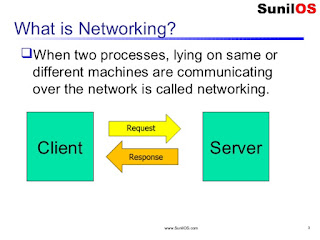Java Networking
Java Networking is a concept of connecting two or more computing devices together so
that we can share resources.
Java
socket programming provides facility to share data between different computing
devices.
 |
| Fig: Java Networking |
Advantage
of Java Networking
1.
sharing
resources
2.
centralize
software management
Java Networking Terminology
The
widely used java networking terminologies are-
1.
IP
Address
2.
Protocol
3.
Port
Number
4.
MAC
Address
5.
Connection-oriented
and connection-less protocol
6.
Socket
1) IP Address
IP
address is a unique number assigned to a node of a network e.g. 192.168.0.1 .
It is composed of octets that range from 0 to 255.
It
is a logical address that can be changed.
2) Protocol
A
protocol is a set of rules basically that is followed for communication.
For example:
- TCP
- FTP
- Telnet
- SMTP
- POP etc.
3) Port Number
The
port number is used to uniquely identify different applications. It acts as a
communication endpoint between applications.
The
port number is associated with the IP address for communication between two
applications.
4) MAC Address
MAC
(Media Access Control) Address is a unique identifier of NIC (Network Interface
Controller). A network node can have multiple NIC but each with unique MAC.
5) Connection-oriented and connection-less protocol
In
connection-oriented protocol, acknowledgement is sent by the receiver. So it is
reliable but slow. The example of connection-oriented protocol is TCP.
But,
in connection-less protocol, acknowledgement is not sent by the receiver. So it
is not reliable but fast. The example of connection-less protocol is UDP.
6) Socket
A
socket is an endpoint between two way communication.
 |
| Fig: Networking |






No comments:
Post a Comment